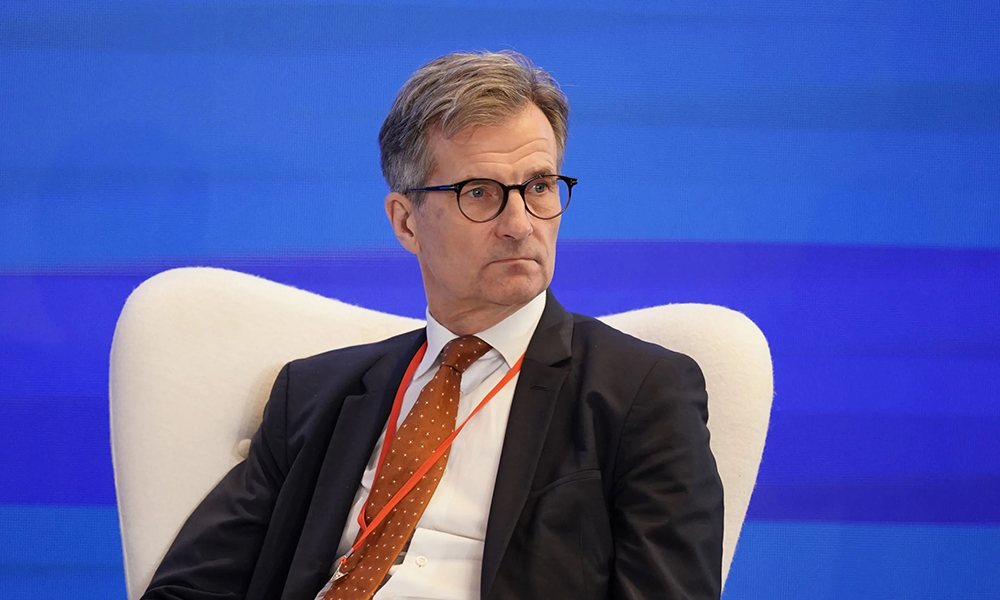
瑞典宣布降息,这一大胆举措令一些分析师大感意外,这也意味着全球货币政策进入了一个新阶段,可能会加速经济扩张,或者让美国等国家恢复更谨慎的货币政策。
5月8日上午,瑞典中央银行(Riksbank)将基准利率从4%下调至3.75%,此前瑞士和匈牙利等其他欧洲小国均宣布通胀最严重的时期已经结束。
瑞典最常用的通胀指标下降至2.2%,接近瑞典央行2%的目标。从表面上来看,这只是从2022年起通过大幅加息来解决问题这种严谨的货币政策获得了合理回报。
但在瑞典经济衰退的形势下,这可能只是一种绝望的信号。
瑞典央行写道:“当通胀接近目标水平而经济活动依旧疲软时,可以放宽货币政策。”
“根据今年3月的预测,如果通胀前景保持不变,预计今年下半年还将有两次政策利率的下调。”
2023年第四季度,瑞典经济同比萎缩0.2%。这是瑞典GDP连续三个季度萎缩。
美联储(Federal Reserve)预计将于今年9月或者10月,在其扩张周期内首次降息,因此瑞典的降息是本世纪首次在美国之前调整利率,而且其他小国可能纷纷效仿。
但长期以来,瑞典央行追随美联储的脚步有合理的理由,而这次大胆的举措给它带来的问题,可能多于此举能够解决的问题。
货币问题
在上周发布的一份报告中,摩根士丹利(Morgan Stanley)直言不讳地分析了瑞典如果在5月降息将会面临的诸多风险。
摩根士丹利的分析师加布里埃拉·斯洛娃指出,虽然通胀回落,但油价上涨、服务业通胀等多方面的压力,可能使瑞典的宏观经济状况变得更加复杂。
此外还有货币的问题,瑞典货币的影响力与美元相比不值一提。
预计在瑞典央行降息后,该国货币克朗将会贬值。降息通常会增加货币供应,导致货币对其他货币贬值。而克朗这种小国货币更是如此。
事实上,5月8日上午,在瑞典央行宣布降息之后,克朗兑美元就贬值了0.5%。
加布里埃拉·斯洛娃写道:“对于瑞典这样一个小型开放型经济体而言,必须高度重视外汇因素、海外利率预期和地缘政治变化。”
与此同时,美联储对降息的态度更加谨慎,努力避免重新陷入数月来才得以控制的通胀周期。
但面对“硬着陆”的威胁,如果长时间加息导致经济衰退,它就可能不得不选择降息。
与此同时,欧洲央行(European Central Bank)预计会在下周追随瑞典央行的脚步,进行降息。欧洲是充当美国降息的小白鼠,还是预示新一轮经济衰退的金丝雀,答案很快就会揭晓。(财富中文网)
译者:刘进龙
审校:汪皓
瑞典宣布降息,这一大胆举措令一些分析师大感意外,这也意味着全球货币政策进入了一个新阶段,可能会加速经济扩张,或者让美国等国家恢复更谨慎的货币政策。
5月8日上午,瑞典中央银行(Riksbank)将基准利率从4%下调至3.75%,此前瑞士和匈牙利等其他欧洲小国均宣布通胀最严重的时期已经结束。
瑞典最常用的通胀指标下降至2.2%,接近瑞典央行2%的目标。从表面上来看,这只是从2022年起通过大幅加息来解决问题这种严谨的货币政策获得了合理回报。
但在瑞典经济衰退的形势下,这可能只是一种绝望的信号。
瑞典央行写道:“当通胀接近目标水平而经济活动依旧疲软时,可以放宽货币政策。”
“根据今年3月的预测,如果通胀前景保持不变,预计今年下半年还将有两次政策利率的下调。”
2023年第四季度,瑞典经济同比萎缩0.2%。这是瑞典GDP连续三个季度萎缩。
美联储(Federal Reserve)预计将于今年9月或者10月,在其扩张周期内首次降息,因此瑞典的降息是本世纪首次在美国之前调整利率,而且其他小国可能纷纷效仿。
但长期以来,瑞典央行追随美联储的脚步有合理的理由,而这次大胆的举措给它带来的问题,可能多于此举能够解决的问题。
货币问题
在上周发布的一份报告中,摩根士丹利(Morgan Stanley)直言不讳地分析了瑞典如果在5月降息将会面临的诸多风险。
摩根士丹利的分析师加布里埃拉·斯洛娃指出,虽然通胀回落,但油价上涨、服务业通胀等多方面的压力,可能使瑞典的宏观经济状况变得更加复杂。
此外还有货币的问题,瑞典货币的影响力与美元相比不值一提。
预计在瑞典央行降息后,该国货币克朗将会贬值。降息通常会增加货币供应,导致货币对其他货币贬值。而克朗这种小国货币更是如此。
事实上,5月8日上午,在瑞典央行宣布降息之后,克朗兑美元就贬值了0.5%。
加布里埃拉·斯洛娃写道:“对于瑞典这样一个小型开放型经济体而言,必须高度重视外汇因素、海外利率预期和地缘政治变化。”
与此同时,美联储对降息的态度更加谨慎,努力避免重新陷入数月来才得以控制的通胀周期。
但面对“硬着陆”的威胁,如果长时间加息导致经济衰退,它就可能不得不选择降息。
与此同时,欧洲央行(European Central Bank)预计会在下周追随瑞典央行的脚步,进行降息。欧洲是充当美国降息的小白鼠,还是预示新一轮经济衰退的金丝雀,答案很快就会揭晓。(财富中文网)
译者:刘进龙
审校:汪皓
Sweden has taken the bold move of cutting interest rates, surprising some analysts and marking a new phase in global monetary policy that could accelerate economic expansion or return countries including the U.S. to a more cautious approach.
The Riksbank moved on May 8 morning to slash its base interest rate from 4% to 3.75%, following other small European countries including Switzerland and Hungary in declaring the worst was over in the battle with inflation.
Sweden’s preferred measure of inflation has fallen to 2.2%, close to the Riksbank’s target of 2%. On the surface, it is a just reward for disciplined monetary policy that saw interest rates rise sharply from 2022 onward to get ahead of the problem.
But with Sweden’s economy in recession, it may just be a sign of desperation.
“When inflation approaches the target while economic activity is weak, monetary policy can be eased,” the Riksbank wrote.
“If the outlook for inflation still holds, the policy rate is expected to be cut two more times during the second half of the year, in line with the forecast in March.”
Sweden’s economy contracted by 0.2% in the fourth quarter of 2023 compared with the same period in 2022. It was the third quarter in a row that Swedish GDP had contracted.
With the Fed expected to cut interest rates for the first time in its expansion cycle in either September or November, this marks the first time this century that Sweden had moved before the U.S. on an interest rate change, and other small countries might follow.
But there were good reasons for the Riksbank following the Fed’s lead for so long, and its leap of faith might leave it with more problems than it solves.
Currency troubles
In a note published last week, Morgan Stanley didn’t sugarcoat the myriad risks Sweden would be taking if it went ahead with a May rate cut.
While inflation has been falling, Morgan Stanley analyst Gabriela Silova pointed out, several pressures including rising oil prices and higher services inflation complicated the macro picture in Sweden.
There is also the issue of its currency, which commands a small fraction of the power of the U.S. dollar.
Sweden’s currency, the krona, is expected to fall in value following the Riksbank’s interest rate cut. Rate cuts typically weaken currency values by increasing the supply of available money relative to other currencies. This is particularly true for smaller currencies like the krona.
Indeed, the krona fell 0.5% against the dollar on May 8 morning following the Riksbank’s announcement.
“With a small open economy like Sweden’s, it is important to put significant weight onto the FX [foreign exchange] considerations, interest rate expectations abroad, and geopolitical developments,” Gabriela Silova wrote.
The Fed, meanwhile, is taking a more cautious approach to rate cutting, keen to avoid being thrown back into an inflationary cycle that has taken months to tame.
But it may be forced to move under threat of a “hard landing,” if a recession results from a longer period of elevated interest rates.
In the meantime, the European Central Bank (ECB) is expected to follow the Riksbank next week with a rate cut of its own. It will soon be clear whether Europe has been a useful guinea pig for the U.S. on rate cuts, or a canary in the coal mine for a renewed economic downturn.






